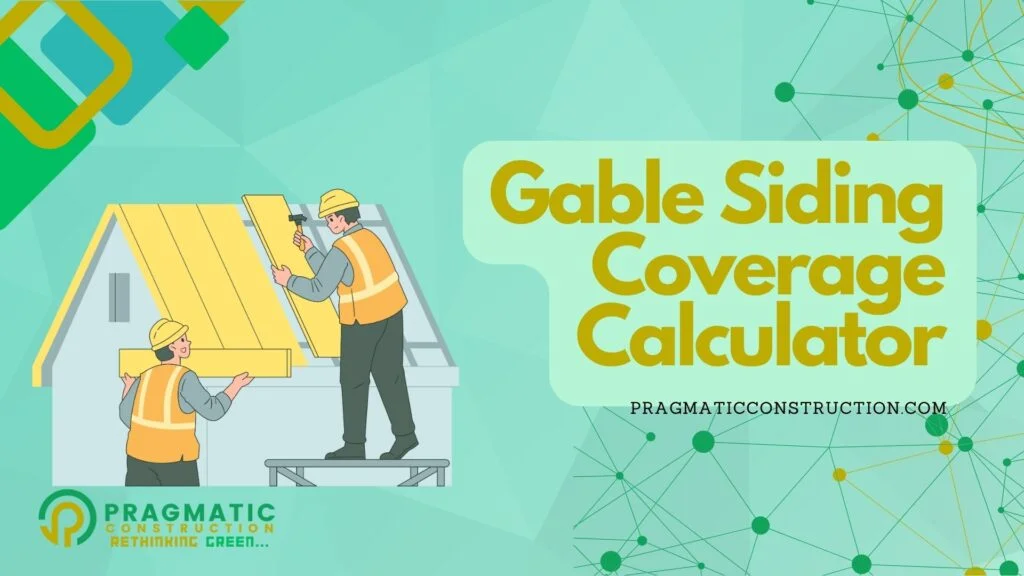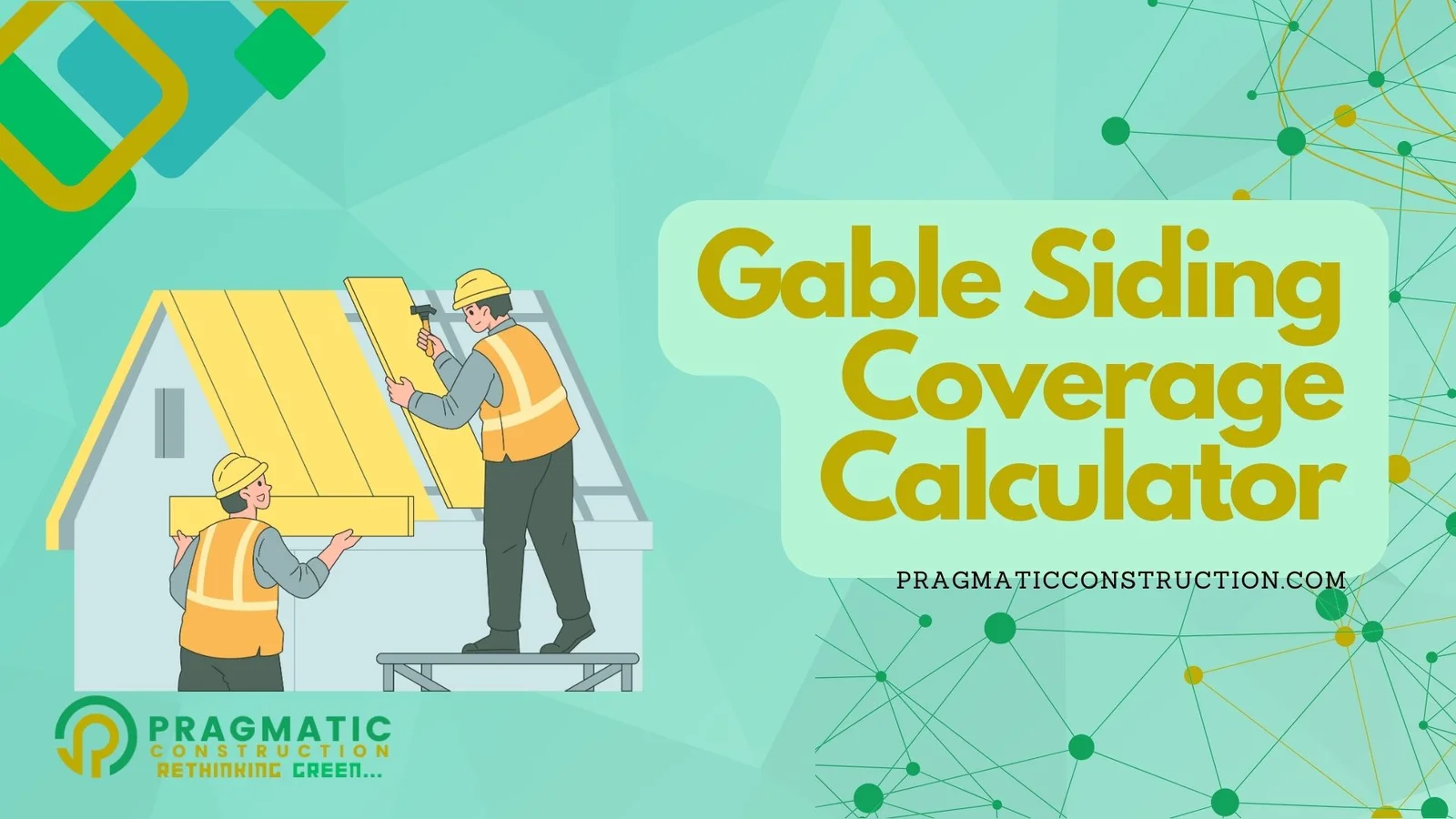Finding area of gable or calculating gable siding is not a straight forward approach. But with our coverage calculator, you don’t have to perform manual calculations. We’re here to help.
Siding is an essential component of any building, providing protection against the elements while enhancing its aesthetic appeal.
Properly measuring and calculating the amount of siding needed is crucial for a successful installation.
In this article, we’ll explore the methods for calculating linear feet of siding, specifically focusing on gable siding, and provide a detailed explanation of the formulas involved.

What is Gable Siding?
Gable siding, also known as gable end siding or gable trim, refers to the triangular section of siding that covers the sloping roof edges on the end of a building.
It is typically installed at the peak of a gable roof, where the two roof slopes meet, creating a triangular space.
This section of siding is essential for providing protection against weather elements and completing the overall look of the building’s exterior.
Purpose of a Gable
The primary purpose of a gable is multi-faceted, encompassing both functional and aesthetic considerations:
Weather Protection: One of the primary functions of gable siding is to provide weather protection to the underlying roof structure.
By covering the exposed ends of the roof, gable siding helps prevent water infiltration, wind damage, and moisture buildup, thereby enhancing the longevity and durability of the roof system.
Ventilation: Gable vents, often integrated into gable siding, facilitate airflow and ventilation within the attic space.
Proper ventilation is essential for regulating temperature and humidity levels, preventing condensation, and reducing the risk of mold and mildew growth. Gable vents promote air circulation, allowing hot air to escape from the attic during summer months and preventing moisture buildup in colder seasons.
Architectural Enhancement: Beyond its functional role, gable siding serves as a key architectural element that adds visual interest and character to a building’s exterior. The distinctive triangular shape of gables contributes to the overall aesthetic appeal, creating a sense of symmetry, balance, and proportion.
Gables can be customized with various siding materials, colors, and textures to complement the architectural style of the building and enhance its curb appeal.
How do you calculate linear feet of siding?
Calculating the linear feet of siding involves determining the total length of siding required to cover a particular area of a building. To calculate linear feet of siding, follow these steps:
Measure the length of each wall: Start by measuring the length of each wall where siding will be installed. Measure from one corner to another along the bottom edge of the wall.
Add up the measurements: Sum up the measurements obtained for all walls to determine the total length of siding needed for the building.
Consider openings and corners: Account for any windows, doors, or corners where siding will not be installed. Subtract the total width of these openings from the total length of siding calculated in step b.
Round up: It’s advisable to add a buffer or round up the final measurement to ensure you have enough siding to cover any unforeseen areas or wastage during installation.
How do you calculate gable siding?
Gable siding refers to the triangular section of siding that covers the sloping roof edges on the end of a building. Calculating gable siding requires determining the area of the triangular gable and converting it to linear feet for siding installation.
a. Measure the dimensions: Measure the width and height of the gable section. The width is the distance from one end of the roof edge to the other, while the height is the vertical distance from the roof edge to the peak.
b. Calculate the area: Use the formula for calculating the area of a triangle, which is 1/2 * base * height. In the case of a gable, the base is the width of the gable, and the height is the height from the roof edge to the peak.
c. Convert to linear feet: Once you have the area of the gable, you can convert it to linear feet by considering the width of the siding panels. Divide the area by the width of the siding panels to determine the linear feet of siding needed for the gable.
What is the formula for calculating siding?
The formula for calculating siding depends on the shape of the area to be covered. For rectangular or square areas, the formula is simply length * height.
However, for irregular shapes such as gables, the formula for the area of a triangle (1/2 * base * height) is used.
How do you find the area of a gable
To find the area of a gable, follow these steps:
- Measure the width and height of the gable section.
- Use the formula for the area of a triangle: 1/2 * base * height, where the base is the width of the gable and the height is the height from the roof edge to the peak.
- Multiply the result by 2 if both sides of the gable require siding, as gables are typically symmetrical.
Installation Guide for Gable Siding:
Installing gable siding requires careful planning, precise measurements, and proper execution to ensure optimal performance and aesthetics. Here’s a step-by-step guide to installing gable siding:
Preparation
Begin by assessing the condition of the existing gable structure and determining the type of siding material to be used. Ensure that the underlying roof structure is structurally sound and free of any damage or deterioration. Gather all necessary tools and materials, including siding panels, trim pieces, fasteners, and caulking.
Measurement
Accurately measure the width and height of the gable section to determine the dimensions of the siding panels needed. Take into account any obstructions or architectural features that may affect the installation process, such as windows, doors, or vents. Calculate the area of the gable to estimate the quantity of siding materials required.
Siding Installation
Start by installing the starter strip along the bottom edge of the gable, ensuring it is level and securely fastened to the underlying structure.
Next, begin attaching the siding panels from the bottom corner of the gable, working your way up towards the peak.
Use appropriate fasteners and spacing to secure the siding panels in place, following manufacturer guidelines.
Trim and Finishing
Once the siding panels are installed, apply trim pieces along the edges and corners of the gable to create a seamless and polished look. Trim pieces help conceal joints, transitions, and rough edges, providing a professional finish to the gable siding. Caulk any gaps or seams to ensure a watertight seal and optimal weather resistance.
Ventilation Considerations
If gable vents are incorporated into the design, carefully cut an opening in the siding to accommodate the vent installation.
Position the vents to maximize airflow and ventilation within the attic space, ensuring they are securely attached and properly sealed to prevent water infiltration.
The Bottom Line
Accurately calculating the linear feet of siding and gable siding is essential for ensuring you purchase the correct amount of materials and complete your siding installation successfully.
By following the steps outlined in this article and understanding the formulas involved, you can confidently tackle siding projects and achieve professional results.
Remember to measure carefully, account for any openings or corners, and round up your calculations to accommodate any potential wastage or adjustments during installation.

















